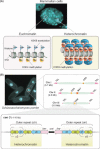RNA and epigenetic silencing: insight from fission yeast
- PMID: 22150237
- PMCID: PMC3380556
- DOI: 10.1111/j.1440-169X.2011.01310.x
RNA and epigenetic silencing: insight from fission yeast
Abstract
Post-translational modifications of histones are critical not only for local regulation of gene expression, but also for higher-order structure of the chromosome and genome organization in general. These modifications enable a preset state to be maintained over subsequent generations and thus provide an epigenetic level of regulation. Heterochromatic regions of the genome are epigenetically regulated to maintain a "silent state" and protein coding genes inserted into these regions are subject to the same epigenetic silencing. The fission yeast Schizosaccharomyces pombe has well characterized regions of heterochromatin and has proven to be a powerful model for elucidation of epigenetic silencing mechanisms. Research in S. pombe led to the breakthrough discovery that epigenetic silencing is not solely a chromatin-driven transcriptional repression and that RNA interference of nascent transcripts can guide epigenetic silencing and associated histone modifications. Over the last 10 years, an eloquent integration of genetic and biochemical studies have greatly propelled our understanding of major players and effector complexes for regulation of RNAi-mediated epigenetic silencing in S. pombe. Here, we review recent research related to regulation of the epigenetic state in S. pombe heterochromatin, focusing specifically on the mechanisms by which transcription and RNA processing interact with the chromatin modification machinery to maintain the epigenetically silent state.
© 2011 The Authors. Development, Growth & Differentiation © 2011 Japanese Society of Developmental Biologists.
Figures



References
-
- Allshire RC, Nimmo ER, Ekwall K, Javerzat JP, Cranston G. Mutations derepressing silent centromeric domains in fission yeast disrupt chromosome segregation. Genes Dev. 1995;9:218–233. - PubMed
-
- Angers S, Li T, Yi X, Maccoss MJ, Moon RT, Zheng N. Molecular architecture and assembly of the DDB1-CUL4A ubiquitin ligase machinery. Nature. 2006;443:590–593. - PubMed
-
- Bannister AJ, Zegerman P, Partridge JF, Miska EA, Thomas JO, Allshire RC, Kouzarides T. Selective recognition of methylated lysine 9 on histone H3 by the HP1 chromo domain. Nature. 2001;410:120–124. - PubMed
Publication types
MeSH terms
Substances
LinkOut - more resources
Full Text Sources

